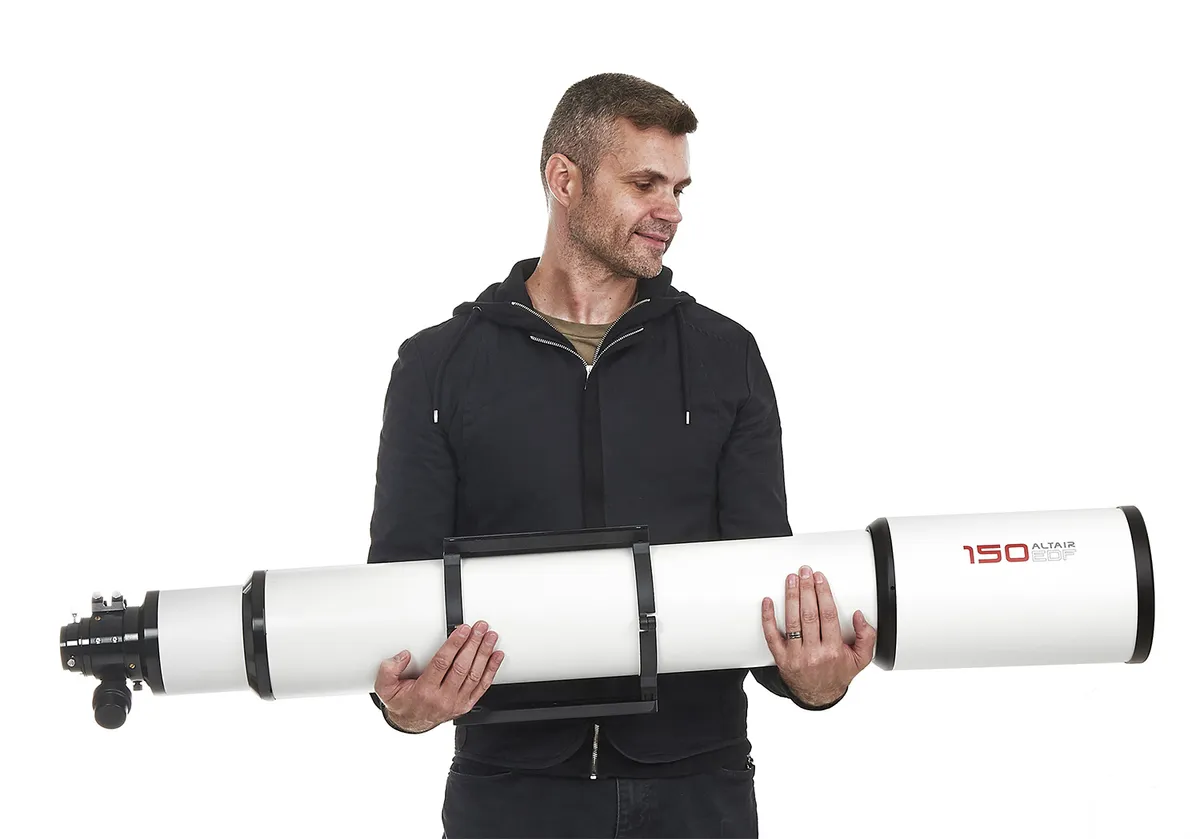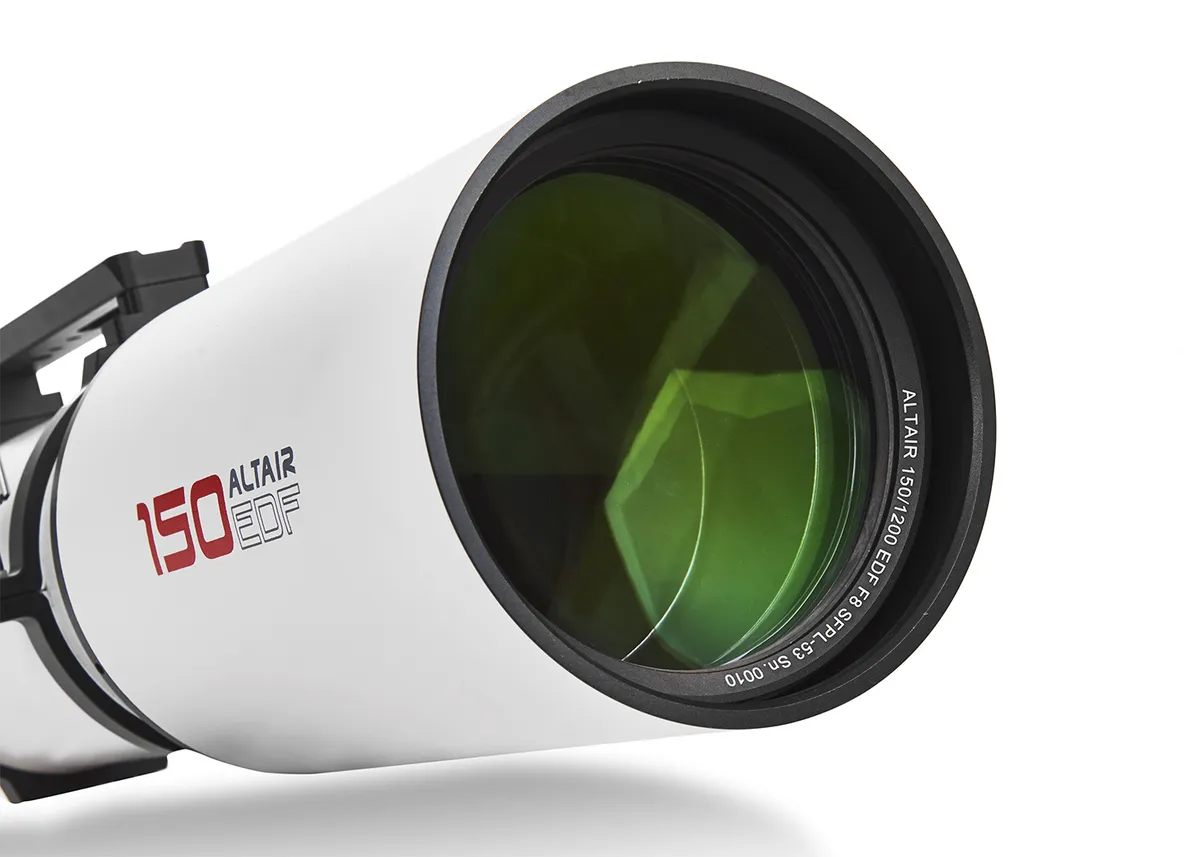For many telescope enthusiasts, a long focal length, 6-inch (150mm) refractor like the Altair 150EDF represents the ultimate piece of equipment, perhaps offering the largest sensible aperture that is practical for dedicated amateurs.
The proportions of the 150EDF are impressive, an f/8 lens giving a focal length of 1,200mm, making ita long scope, especially with the dew shield extended.
We mounted it onto our permanent pier (post) in a compact observatory and it quickly dominated the observing area.
Long refractors make for some interesting observing positions, so it’s prudent to think about how and where you might mount and use one.
After allowing a couple of hours for the scope to adjust to the ambient temperature we performed a star test to make sure the optics had survived the shipping process, although in regular use we found that generally 30 minutes cooling time was enough.
The telescope tested well, and returned a clean, round pinpoint star image, with a good airy disc at focus.
Ramping the magnification up to an extreme 535x demonstrated the capability of the optics to deliver high-quality star views, and it really whet our appetite for some double-star observing.

Going after the gas giants
The 150EDF will appeal especially to observers who enjoy our Solar System’s objects, and although circumstances conspired to deny us any lunar or solar viewing sessions, the views it produced of both Jupiter and Saturn were quite outstanding – despite these two being very poorly positioned for UK observers this season.
Our 10mm eyepiece produced 120x magnification, which gave a sensible compromise given the seeing conditions at Jupiter’s low altitude, and revealed clear natural colours, patterns and deviations in the belts and a distinct Great Red Spot.
Saturn, slightly higher, was even more impressive, accepting 240x magnification and displaying coloured bands on the disc, with a sharp, clean Cassini Division and some variations in the rings too.
We even managed a peek at Neptune, which displayed a clear disc shape.
Moving out of the Solar System and onto some favourite double stars, we turned first to Epsilon (ε) Lyrae, the Double Double. As expected, the split here was clean, and using a 2x Barlow lens and 4.5mm eyepiece at 535x provided a superb view: all four stars round and distinct with perfect airy discs just touching for each pair.
Positioned high overhead, the viewing position was awkward, but well worth it for the view.
Next was Iota (ι) Cassiopeiae, an intriguing multiple star system, with three observable close stars offering varying colours.
These were easily split and the colour distinction was obvious.

Sitting pretty
With the scope’s technical credentials demonstrated by the high-magnification viewing, it was time to enjoy the prettier sights.
Albireo was delightful, the star cluster M52, sharp and spangly, and in a 21mm, 100° eyepiece, the Andromeda Galaxy was almost touchable, flanked by its companions M32 and M110.
The same eyepiece drew on the Altair’s 150mm window to provide a stunning visual offering of the Double Cluster in Perseus, confirming the advantages of a large aperture refractor for visual astronomy.
Such enjoyable visuals left us wondering how the scope would perform with a camera attached.
With no field-flattener available to us, we used our small-chip Atik 460 cameras for both mono and colour images.
This gave a flat result with no effects from coma even in the corners, and the star images were tight and round throughout, even with the OSC (One Shot Colour) camera that we used on smaller targets like M27, M57, and Albireo, to capitalise on the 150EDF’s long focal length.
Turning to the Bubble Nebula, NGC 7635, a favourite narrowband target, a mono camera with narrowband filters revealed the good contrast and faint light transmission offered by the telescope lens.
With excellent all-round visual performance and imaging capability, the Altair 150EDF is sure to be at the top of many hobbyist wish-lists.
In glowing colours
The quality of the view at an eyepiece, or camera, is affected by the colour correction of the optics.
Perfect optics bring all colours together to a single point of focus, providing the sharpest views.Less capable lenses produce bright haloes of colour around bright objects.
For years, natural fluorite lenses were favoured for their colour-handling properties, but had undesirable qualities too, being brittle and expensive.
The Altair 150EDF’s apochromatic doublet lens uses S-FPL53 manufactured glass, which has a refractive index similar to fluorite, without the problems.
Our views of Saturn and Jupiter were natural, with no evidence of colour aberrations at all. Tests with a camera and filters confirmed that Red, Green, and Blue wavelengths of light come to a close point of focus in the 150EDF, even comparable with premium triplet lens refractors.
It’s this impressive correction that allows the use of higher power eyepieces while maintaining sharp star images, so you can push magnification further as conditions allow.

Focuser
Suitable for observing or photography, the dual-speed rack and pinion focuser is smooth, precise and fully rotatable.The drawtube has marked millimetre graduations and extends 95mm. A star diagonal is necessary to achieve eyepiece focus, and an extension tube is needed for a camera if used without a diagonal.
Size and scale
With the dew shield and focuser extended, the 150EDF is 140cm in length and weighs around 10kg, but we found it to be quite manageable and we mounted it single-handedly. Accessories like cameras or diagonals add length and weight and help to counterbalance the front-heavy scope.
Tube rings
The 150EDF is supplied with well-machined rings, with a fitted Vixen-style dovetail bar on the bottom and a rounder-style bar on top. This acts as a carrying handle or an accessory-mounting rail with multiple fitting points.
Baffles
Peering down through the lens reveals a series of internal tube baffles, which decrease in size as they get nearer to the focuser. These act as light-blocking barriers and reduce the impact that unwanted light sources have on the scope views.
Dew shield
The dew shield protects the objective lens from the unwanted effects of dew and stray light. It can be fixed in place with an Allen key (not supplied) and lengthens the scope by 22cm, making a difference to its size and balance.
Vital stats
Price £2,599
Optics S-FPL53 apochromatic doublet
Aperture 150mm (6-inch)
Focal length 1,200mm, f/8
Focuser Dual-speed 1:10 rack and pinion
Length with dew shield retracted 1m
Weight 10.7kg
Supplier Altair Astro
Tel 01263 731505

